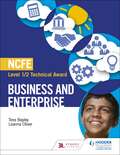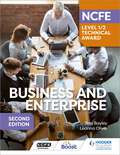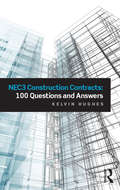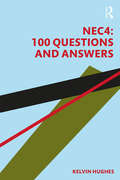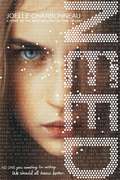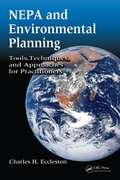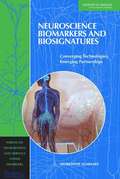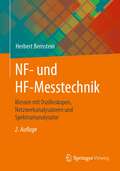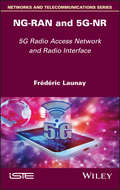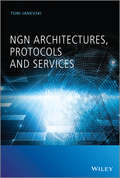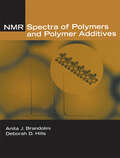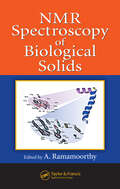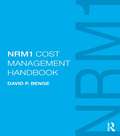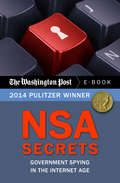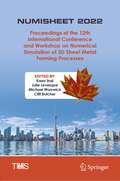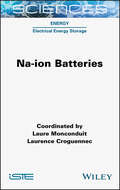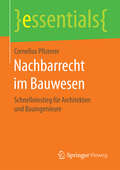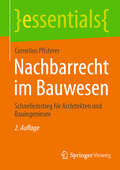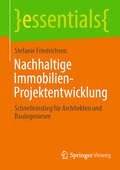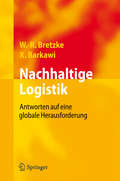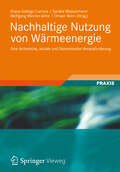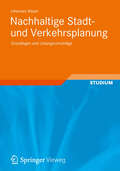- Table View
- List View
NCFE Level 1/2 Technical Award in Business and Enterprise
by Tess Bayley Leanna OliverBuild your knowledge and develop the practical enterprise skills you need to achieve the Level 1/2 Technical Award with this brand new textbook, endorsed by NCFE and written by business and enterprise experts Tess Bayley and Leanna Oliver.- Access the information you need using the clear and attractive layout. - Test your knowledge and understanding, with activities and Test Yourself questions throughout.- Reinforce the knowledge and skills you need for both the written exam and synoptic project.- Endorsed by NCFE for the 2018 specification, which is approved for inclusion in the 2020, 2021 and 2022 Key Stage 4 performance tables.
NCFE Level 1/2 Technical Award in Business and Enterprise Second Edition
by Tess Bayley Leanna OliverThis Student Textbook is:- Comprehensive - gain in-depth knowledge of each content area with clear explanations of every concept and topic and easy-to-follow chapters.- Accessible, reliable and trusted - structured to match the specification and provide you with the information you need to build knowledge, understanding and skills.- Designed to support you - boost your confidence when tackling the internal non-examined and external examined assessments with plenty of activities to test and consolidate knowledge.- Your go-to guide - expert authors have carefully designed tasks and activities to build your skillset in order to aid progression and questions to assess understanding.
NCFE Level 1/2 Technical Award in Business and Enterprise Second Edition
by Tess Bayley Leanna OliverThis Student Textbook is:- Comprehensive - gain in-depth knowledge of each content area with clear explanations of every concept and topic and easy-to-follow chapters.- Accessible, reliable and trusted - structured to match the specification and provide you with the information you need to build knowledge, understanding and skills.- Designed to support you - boost your confidence when tackling the internal non-examined and external examined assessments with plenty of activities to test and consolidate knowledge.- Your go-to guide - expert authors have carefully designed tasks and activities to build your skillset in order to aid progression and questions to assess understanding.
NEC3 Construction Contracts: 100 Questions And Answers
by Kelvin HughesWhich member of the NEC3 family of contracts should I use? How do I choose and use my main and secondary options? What are the roles and responsibilities of the various parties? How should I effectively manage early warnings and compensation events? Important questions can arise when working with NEC3 contracts, some of them have simple answers and others require more a detailed response. Whether you are an NEC3 beginner or an expert, the 100 questions and answers in this book are a priceless reference to have at your fingertips. Covering issues that can arise from the full range of NEC3 forms, Kelvin Hughes draws on questions he has been asked during his 20 years working with NEC and presenting training courses to advise, warn of common mistakes, and explain in plain English how these contracts are meant to be used.
NEC4: 100 Questions and Answers
by Kelvin HughesThis book details some of the most important and interesting questions raised about the NEC4 family of contracts and provides clear, comprehensive answers to those questions. Written by an NEC expert with over 20 years’ experience using, advising and training others, the book has several distinctive features: It covers the whole NEC4 family It is written by a very experienced NEC author who explains sometimes complex issues in a simple and accessible style The questions and answers range from beginner level up to a masterclass level The questions are real life questions asked by actual NEC practitioners on real projects. The book includes questions and answers relating to tendering, early warnings, programme issues, quality management, payment provisions, compensation events, liabilities, insurances, adjudication, termination and much more. It is essential reading for anyone working with the NEC4 family of contracts, whether professionals or students in construction, architecture, project management and engineering.
NEED
by Joelle Charbonneau"No one gets something for nothing. We all should know better." Teenagers at Wisconsin's Nottawa High School are drawn deeper into a social networking site that promises to grant their every need . . . regardless of the consequences. Soon the site turns sinister, with simple pranks escalating to malicious crimes. The body count rises. In this chilling YA thriller, the author of the best-selling Testing trilogy examines not only the dark side of social media, but the dark side of human nature.
NEPA and Environmental Planning: Tools, Techniques, and Approaches for Practitioners
by Charles H. EcclestonA tool for predicting environmental impacts, the National Environmental Policy Act (NEPA) can also be used to predict the impacts of natural disasters and potential terrorist attacks. This book demonstrates how to use NEPA as a framework to support decision-making. It includes examples that demonstrate how NEPA can be efficiently integrated with other processes such as ISO 14001, P2, and Adaptive Management. It provides proven tools, techniques, and approaches for streamlining NEPA and environmental planning strategies that reduce the potential for controversy and criticism. It is the first text that covers recent changes to NEPA and the new CEQ guidance expected to be issued.
NEUROSCIENCE BIOMARKERS AND BIOSIGNATURES: Converging Technologies, Emerging Partnerships
by Institute of Medicine of the National AcademiesBiomarkers, or biological markers, are quantitative measurements that offer researchers and clinicians valuable insight into diagnosis, treatment and prognosis for many disorders and diseases. A major goal in neuroscience medical research is establishing biomarkers for disorders of the nervous system. Given the promising potential and necessity for neuroscience biomarkers, the Institute of Medicine™ Forum on Neuroscience and Nervous System Disorders convened a public workshop and released the workshop summary entitled Neuroscience Biomarkers and Biosignatures: Converging Technologies, Emerging Partnerships. The workshop brought together experts from multiple areas to discuss the most promising and practical arenas in neuroscience in which biomarkers will have the greatest impact. The main objective of the workshop was to identify and discuss biomarker targets that are not currently being aggressively pursued but that could have the greatest near-term impact on the rate at which new treatments are brought forward for psychiatric and neurological disorders.
NF- und HF-Messtechnik: Messen mit Oszilloskopen, Netzwerkanalysatoren und Spektrumanalysator
by Herbert BernsteinDas Buch beschreibt Digital-Oszilloskope, Netzwerk- und Spektrumanalysatoren, die in Forschung, Lehre und Praxis zu den wichtigsten Messgeräten gehören. Diese Messgeräte können von Multisim simuliert werden. Ein großer Vorteil beim Einsatz von Simualtionswerkzeugen ist, dass bei fehlerhaftem Messaufbau und -verfahren und grundsätzlichen Messfehlern weder Messgeräte noch Messobjekte zerstört werden. Neben den mess- und elektrotechnischen Grundlagen werden zahlreiche Messaufgaben beschrieben.
NG-RAN and 5G-NR: 5G Radio Access Network and Radio Interface
by Frederic LaunayNG-RAN and 5G-NR describes the deployment of 5G NSA (non standalone 5G) and 5G-SA (standalone 5G). 5G-NSA deals with radio access entities. For the 5G-NSA mode, dual MR DC connectivity is based on radio measurements, allowing the master 4G base station MeNB to add or remove a secondary 5G node SgNB.This book describes the architecture of the NG radio access network and the 5G-NR radio interface according to the 3GPP (3rd Generation Partnership Project) specifications. The overall architecture of the NG-RAN, including the NG, Xn and F1 interfaces and their interaction with the radio interface, are also described. The 5G-NR physical layer is mainly connected by implementing antennas, which improves transmission capacity. 5G-SA deals with the 5G Core network.In the 5G-SA model, the mobile is attached to the 5G Core network through NG-RAN. The book explains radio procedure, from switching on a device to establishing a data connection, and how this connection is maintained even if mobility is involved for both 5G-SA and 5G-NSA deployment. NG-RAN and 5G-NR is devoted to the radio access network, but mobile registration, establishment procedures and re-establishment procedures are also explained.
NGN Architectures, Protocols and Services
by Toni JanevskiComprehensive coverage explaining the correlation and synergy between Next Generation Networks and the existing standardized technologies This book focuses on Next Generation Networks (NGN); in particular, on NGN architectures, protocols and services, including technologies, regulation and business aspects. NGN provides convergence between the traditional telecommunications and the Internet, and it is globally standardized by the ITU (International Telecommunication Union), where ITU is the United Nations specialized agency for Information and Communication Technologies – ICTs. The convergence towards the NGN is based on the Internet technologies, and the introductory chapters cover the Internet fundamentals of today, including architectures, protocols (IPv4, IPv6, TCP, DNS, etc.), Internet services (WWW, e-mail, BitTorrent, Skype, and more), as well as Internet governance. Further, the prerequisite for convergence of all ICT services over single network architectures is broadband access to the Internet. Hence, the book includes architectures of fixed broadband Internet access networks, such as DSL (Digital Subscriber Line) networks, cable networks, FTTH (Fiber To The Home), next generation passive and active optical networks, and metro Ethernet. It also covers network architectures for next generation (4G) mobile and wireless networks (LTE/LTE-Advanced, and Mobile WiMAX 2.0), then Fixed Mobile Convergence - FMC, next generation mobile services, as well as business and regulatory aspects for next generation mobile networks and services. Comprehensive coverage explaining the correlation and synergy between Next Generation Networks and the existing standardized technologies Focuses on Next Generation Networks (NGN) as defined by the ITU, including performance, service architectures and mechanisms, common IMS (IP Multimedia Subsystem), control and signalling protocols used in NGN, security approaches, identity management, NGN Service Overlay Networks, and NGN business models Examines the most important NGN services, including QoS-enabled VoIP, IPTV over NGN, web services in NGN, peer-to-peer services, Ubiquitous Sensor Network (USN) services, VPN services in NGN, Internet of things and web of things Includes the transition towards NGN from the PSTN (Public Switched Telephone Networks) and from the best-effort Internet via the same Internet access Explores advanced topics such as IPv6-based NGN, network virtualization, and future packet based networks, as well as business challenges and opportunities for the NGN evolved networks and services Essential reading for engineers and employees from regulatory bodies, government organisations, telecommunication companies, ICT companies.
NMR Spectra of Polymers and Polymer Additives
by Anita J. Brandolini Deborah D. Hills"Compiles nearly 400 fully assigned NMR spectra of approximately 300 polymers and polymer additives, representing all major clases of materials: polyolefins, styrenics, acrylates, methacrylates, vinyl polymers, elastomers, polyethers, polyesters, polymides, silicones, cellulosics, polyurethanes, plasticizers, and antioxidants."
NMR Spectroscopy of Biological Solids
by A. RamamoorthyOver the past decade, a myriad of techniques have shown that solid-state nuclear magnetic resonance (NMR) can be used in a broad spectrum of applications with exceptionally impressive results. Solid-state NMR results can yield high-resolution details on the structure and function of many important biological solids, including viruses, fibril-formin
NRM1 Cost Management Handbook
by David P BengeThe definitive guide to measurement and estimating using NRM1, written by the author of NRM1 The 'RICS New rules of measurement: Order of cost estimating and cost planning of capital building works' (referred to as NRM1) is the cornerstone of good cost management of capital building works projects - enabling more effective and accurate cost advice to be given to clients and other project team members, while facilitating better cost control. The NRM1 Cost Management Handbook is the essential guide to how to successfully interpret and apply these rules, including explanations of how to: quantify building works and prepare order of cost estimates and cost plans use the rules as a toolkit for risk management and procurement analyse actual costs for the purpose of collecting benchmark data and preparing cost analyses capture historical cost data for future order of cost estimates and elemental cost plans employ the rules to aid communication manage the complete 'cost management cycle' use the elemental breakdown and cost structures, together with the coding system developed for NRM1, to effectively integrate cost management with Building Information Modelling (BIM). In the NRM1 Cost Management Handbook, David Benge explains in clear terms how NRM1 is meant to be used in familiar quantity surveying tasks, as well as a range of activities of crucial importance for professionals in years to come. Worked examples, flow charts, diagrams, templates and check lists ensure readers of all levels will become confident and competent in the use of NRM1. This book is essential reading for anyone working with NRM1, and is the most authoritative guide to practice available for those preparing to join the industry.
NSA Secrets: Government Spying in the Internet Age
by The Washington PostThe Pulitzer Prize–winning investigation into surveillance abuses and the Edward Snowden case that brought them to light. The NSA's extensive surveillance program has led Americans to question threats to their privacy. As reported by the Washington Post, in their Pulitzer Prize-winning coverage of whistleblower Edward Snowden's NSA leaks, NSA Secrets delves into the shadowy world of information gathering, exposing how data about you is being collected every day. From his earliest encrypted exchanges with reporters, Edward Snowden knew he was a man in danger. Sitting on a mountain of incriminating evidence about the NSA surveillance programs, Snowden was prepared to risk his freedom, and his very life, to let the world know about the perceived overreach of the NSA and the massive collection of personal information that was carried out in the name of national security by the U.S. government. The Washington Post&’s complete coverage of the NSA spying scandal, which it helped break, is now collected in one place to give as comprehensive a view of the story as is known. From the first contact with Snowden to the latest revelations in worldwide cellphone tracking, the award-winning reporters at the Post have vigorously reported on the scope of the NSA&’s surveillance. Snowden called the internet &“a TV that watches you,&” and accused the government of &“abusing [it] in secret to extend their powers beyond what is necessary and appropriate.&” Here, the secrets of those who tried in vain to remain in the shadows are revealed.
NUMISHEET 2022: Proceedings of the 12th International Conference and Workshop on Numerical Simulation of 3D Sheet Metal Forming Processes (The Minerals, Metals & Materials Series)
by Cliff Butcher Kaan Inal Julie Levesque Michael WorswickThe NUMISHEET conference series is the most significant international conference on the area of the numerical simulation of sheet metal forming processes. It gathers the most prominent experts in numerical methods in sheet forming processes and is an outstanding forum for the exchange of ideas and for the discussion of technologies related to sheet metal forming processes. Topics covered in this volume include but are not limited to the following: Materials Modeling and Experimental Testing MethodsFriction and ContactFormability, Necking, and FractureInstabilities and Surface DefectsFracture and DamageNumerical MethodsSpringbackIncremental Sheet FormingRoll FormingInnovative Forming MethodsProduct and Process Design and Optimization
Na-ion Batteries
by Laure Monconduit Laurence CroguennecThis book covers both the fundamental and applied aspects of advanced Na-ion batteries (NIB) which have proven to be a potential challenger to Li-ion batteries. Both the chemistry and design of positive and negative electrode materials are examined. In NIB, the electrolyte is also a crucial part of the batteries and the recent research, showing a possible alternative to classical electrolytes – with the development of ionic liquid-based electrolytes – is also explored. Cycling performance in NIB is also strongly associated with the quality of the electrode-electrolyte interface, where electrolyte degradation takes place; thus, Na-ion Batteries details the recent achievements in furthering knowledge of this interface. Finally, as the ultimate goal is commercialization of this new electrical storage technology, the last chapters are dedicated to the industrial point of view, given by two startup companies, who developed two different NIB chemistries for complementary applications and markets.
Nachbarrecht im Bauwesen: Schnelleinstieg für Architekten und Bauingenieure (essentials)
by Cornelius PfistererCornelius Pfisterer erkl#65533;rt die Grundbegriffe zum Grundst#65533;cks- und Nachbarrecht und zeigt auf, was der Nachbar bei einem Bauvorhaben dulden muss und was er abwehren kann. In diesem essential erfahren Sie, wie das Hammerschlags- und Leiterrecht zugunsten des Bauherrn auch formal richtig geltend zu machen ist. Wichtige Unterschiede zwischen #65533;ffentlichem und privatem Recht werden erl#65533;utert. Praktische Hinweise zur Gestaltung einer Nachbarvereinbarung erg#65533;nzen die Darstellung der Rechtsgrundlagen. Wer sich hier nicht auskennt, riskiert gerade bei innerst#65533;dtischen Bauvorhaben aufgrund nachbarlicher Einwendungen erhebliche Bauverz#65533;gerungen, Planungs#65533;nderungen und Mehrkosten. Hier finden Sie die rechtlich-formalen L#65533;sungen, wenn bspw. eine Unterfangung des Nachbargeb#65533;udes erforderlich wird, W#65533;rmed#65533;mmma#65533;nahmen im Bestand geplant sind oder ein Baukran das Nachbargrundst#65533;ck #65533;berschwenken muss.
Nachbarrecht im Bauwesen: Schnelleinstieg für Architekten und Bauingenieure (essentials)
by Cornelius PfistererDieses essential vermittelt Ihnen die Grundbegriffe zum Grundstücks- und Nachbarrecht. Sie erfahren, was der Nachbar bei einem Bauvorhaben dulden muss und was er abwehren. Es wird erläutert, wie das Hammerschlags- und Leiterrecht zugunsten des Bauherrn auch formal richtig geltend zu machen ist. Wichtige Unterschiede zwischen öffentlichem und privatem Recht werden erklärt. Praktische Hinweise zur Gestaltung einer Nachbarvereinbarung ergänzen die Darstellung der Rechtsgrundlagen. Wer sich hier nicht auskennt, riskiert gerade bei innerstädtischen Bauvorhaben aufgrund nachbarlicher Einwendungen erhebliche Bauverzögerungen, Planungsänderungen und Mehrkosten. Hier finden Sie die rechtlich-formalen Lösungen, wenn eine Unterfangung des Nachbargebäudes erforderlich wird, Wärmedämmmaßnahmen im Bestand geplant sind oder ein Baukran das Nachbargrundstück überschwenken muss. In der 2., überarbeiteten Auflage wurden zahlreiche gesetzliche Neuerungen berücksichtigt und aktuelle Rechtsprechung eingepflegt.
Nachhaltige Entwicklung technischer Produkte und Systeme: Der Ingenieurberuf im Wandel
by Jürgen H. FranzDas Buch erläutert ausgehend vom Begriff der Nachhaltigkeit die Anforderungen an die Herstellung technischer Systeme. Es erklärt die Lebensphasen eines Produktes, die Rolle der Nachhaltigkeit in diesen Phasen und die sich daraus ergebenden Konsequenzen für den Ingenieur und die Ingenieurin sowie für die Ausbildung in den ingenieurwissenschaftlichen Studiengängen. Das Buch zeigt, dass durch die Anforderungen, welche die Nachhaltigkeit setzt, der Ingenieurberuf noch vielseitiger und spannender, aber auch verantwortungsvoller wird, als er ohnehin schon ist.
Nachhaltige Immobilien-Projektentwicklung: Schnelleinstieg für Architekten und Bauingenieure (essentials)
by Stefanie FriedrichsenDieses Essential beleuchtet die zentralen Aspekte und Abläufe bei der Entwicklung nachhaltiger Immobilien. Von der Zustandsanalyse über die Projektidee bis hin zur Wirtschaftlichkeitsanalyse werden wichtige Schritte und Konzepte erläutert, um eine langlebige, ökologische und sozialverträgliche Immobilie zu gestalten, die zugleich wirtschaftlichen Erfolg verspricht.
Nachhaltige Logistik
by Wolf-Rüdiger Bretzke Karim BarkawiDie Reduzierung von Schadstoffemissionen, Ölpreissteigerungen und eine überlastete Verkehrsinfrastruktur haben die Rahmenbedingungen der Logistik in den letzten Jahren völlig verändert. Die aktualisierte Neuauflage des Werks greift die Änderungen in der Umweltpolitik auf, die den Kontext unternehmerischer Entscheidungen bestimmen. Anpassungsstrategien werden vorgestellt und Themen wie Kreislaufwirtschaft, Prozess- und Netzwerkredesign, Citylogistik und Globalisierung anhand einer deutlich erhöhten Anzahl von Graphiken und Praxisbeispielen erörtert.
Nachhaltige Nutzung von Wärmeenergie: Eine technische, soziale und ökonomische Herausforderung
by Diana Gallego Carrera, Sandra Wassermann, Wolfgang Weimer-Jehle and Ortwin RennDas Buch gibt Antworten auf die Frage, wie Wärmeenergie in Privathaushalten nachhaltig genutzt werden kann. Hierzu wird das Thema entlang des Dreiklangs von Suffizienz-, Konsistenz- und Effizienzstrategien interdisziplinär beleuchtet. Die Autoren zeigen sowohl von der Wärmeenergienutzerseite, als auch von der technologischen Seite Anreize und Hemmnisse für eine nachhaltige Nutzung der Wärmeenergie in Privathaushalten auf. Die umfassende und interdisziplinäre Darstellung des Themas bietet sowohl Nutzern als auch Fachleuten einen umfassenden Einblick in das Themenfeld der Wärmeenergienutzung in Privathaushalten.
Nachhaltige Rückbau- und Entsorgungsplanung: Erarbeitung eines Rückbau- und Entsorgungskonzeptes im Bereich des Einzelhandels (Entwicklung neuer Ansätze zum nachhaltigen Planen und Bauen)
by Jonas ScharkeDas Buch beschreibt die Herangehensweise an die Entsorgung- und den Rückbau im Einzelhandel unter vorrangig ökologischen Gesichtspunkten. Hierbei stehen die Strukturierung und die Ablaufplanung des Rückbaus im Kontext der Einzelhandelsexpansion im Fokus. Dies umfasst die Darstellung und Berücksichtigung auftretender Besonderheiten sowie hieraus entwickelte Lösungsvorschläge im praktischen Umgang. Das entstehende Konzept dient dabei als Wegweiser für Unternehmen, perspektivisch nachhaltige Aspekte in der Rückbauplanung zu manifestieren.“
Nachhaltige Stadt- und Verkehrsplanung
by Johannes MeyerAusgehend von den Grundlagen des Städtebaus beschäftigt sich dieses Buch mit dem besonderen Aspekt der Nachhaltigkeit in der aktuellen Stadt- und Verkehrsentwicklung und dem Umgang mit bestehenden städtebaulichen Strukturen. Die Themen Demographischer Wandel, Energieeinsparung, Umwelt- und Klimaschutz stehen dabei im Fokus. Es enthält sowohl grundlegende Informationen als Einstieg in die Thematik als auch konkrete Beispiele aus der Praxis.
